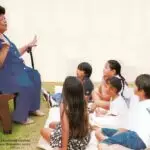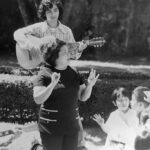Clotilde "Ding" Castro Gould





Table of Contents
Share This
Storyteller, educator, language advocate
Clotilde “Ding” Castro Gould (1930 – 2002) was a beloved storyteller, educator and advocate for CHamoru/Chamorro language and culture. Through her sense of humor and gift for weaving stories and songs together about Chamorros and life on Guam, Gould helped create and shape Chamorro language resources and programs on Guam, as well as advanced cultural awareness of the Marianas in the larger Pacific region.
Gould was born in 1930 in Hagåtña, the daughter of Juan Castro Castro, a tailor. Although she did not grow up with her mother, her name was Antonia, and Gould heard she was an active midwife after World War II. Instead, Gould was raised by her paternal grandmother, her father and his youngest sister. When her aunt married and had children of her own, these cousins became more like siblings. Juan Castro supported the whole family up to his death.
With such a full household, Gould was able to have an exciting and love-filled childhood. In fact, Gould attributed her storytelling skills to her paternal grandmother. Her early childhood memories were filled with stories her grandmother told her and her siblings, especially at bedtime—tales from the Spanish era, always ending with a moral or lesson to be learned. Gould learned to embellish stories the way her grandmother did, adding suspense and surprise with each retelling.
A motivated and bright student, Gould, like many other children on Guam at that time, had her education interrupted by the Japanese occupation and World War II in the early 1940s. Many memories from war times involved difficulties during the Japanese occupation. Throughout her hardships, Gould maintained her strong will. One such incident involved her being taken from her home in Hagåtña by Japanese soldiers and forced, along with a few others, to walk to the rice paddies in Malesso. Gould escaped and found her way home. Another incident involved Gould’s encounter with a Japanese soldier who prodded her with a shotgun and told her to bow. Instead, she started singing “God Bless America.”
Toward the end of the war Gould and her family were sent to the concentration camp in Manenggon valley, Yona, where they stayed until the island was liberated by the United States. It was during their time in the camp that the family experienced the most hardship, under constant guard by the Japanese soldiers and with little food and shelter against the weather. Gould’s family survived on breadfruit and anything else they found in the jungle. If they were lucky enough to find a chicken, they would boil it over and over again for the thin broth.
When the Americans came, all the residents of the camp, including Gould’s family, were overjoyed, running to greet the soldiers. Like other liberated Chamorros, young Gould felt her family’s hardships were over. She and her siblings were then able to return to school and finish their education after the war.
Before and after the war Gould was very active in the Catholic Church. She was a member of the Sodality of Mary (a church organization for young, unmarried girls), a member of the choir, a catechist (or lay teacher of the Catholic faith), and did other work for the Agana Heights parish. Her love of music and singing found expression in the church choir and in her own musical compositions — her mischievous or rebellious side sometimes coming through in her lyrics.
Gould also was active in school, serving as student council representative and as a member of the Civic and Playhouse clubs. She graduated from George Washington High School in 1951, and received a full scholarship to Barat College of the Sacred Heart in Lake Forest, Illinois, a rarity in those days. She attended Barat College from 1951 to 1954. Even then, she would regale her friends in the dormitories with taotaomo’na stories from Guam and other tales.
Upon her return to Guam in 1954, Gould became an educator, although she had already been working since 1949 as an elementary school teacher. She taught high school from 1954 to 1958. She married Silas Edward Gould, an American, and left again for the continental United States where she taught, first in Kansas City, Missouri, then in Riverside and Pleasant Hill in California until 1972. The Goulds raised their only daughter, Sandy, while in the States.
Longing to reconnect with her island roots, Gould began to engage with other Chamorros who had relocated to California, setting up different social activities for the Chamorro community there. However, her chance to return home came in 1972 when her aunt became ill and Gould decided to take care of her. She took a job with the Department of Education (DOE) as a Language Arts Consultant. With her proficiency in Chamorro she promoted Chamorro language for DOE and developed a series of children’s texts to teach the language, including I Niyok yan I Manha (The Ripe Coconuts and the Young Coconuts), I Un Punidera Yan I Dies Na Babui (The Hen and the Ten Pigs), and Si Patas Nganga’ (Patas the Duck), all published in 1973.
When the Government of Guam enacted the Chamorro Language and Culture Program with federal funding, Gould became the project director. She helped develop the Chamorro language curriculum for the elementary schools and train teachers for the new curriculum. It was during her tenure that governmental support for Chamorro language, music and culture reached new highs, as even the courts and government agencies began to translate signs and other important materials and commercials into the Chamorro language.
Throughout her career, Gould served on numerous education committees and task forces. While at DOE, she served as chairperson of Na Bunita from 1974 to 1977, and as vice-chairperson of the International Women’s Conference in 1977, and as vice-chairperson of the Chamorro Language Commission (1980-1983). In 1980, she was appointed the Administrator of Chamorro Studies and Special Projects Division at DOE. From 1981 to 1983, she was the chairperson of the Retired Senior Citizens Advisory Council. In 1981, she organized the Guam Genealogical Society to help research and preserve genealogies and family histories of Guam’s people.
In addition to her work in education and other civic organizations, Gould was also an activist. She was a member of the People’s Alliance for Responsible Alternatives (PARA) and also the Organization of People for Indigenous Rights (OPI-R), two grassroots organizations that advocate political awareness and change, especially regarding issues of language, culture and political rights for the Chamorro people.
In the 1981 strike led by the Guam Federation of Teachers, Gould joined other educators to form the Organization of Non-striking Employees to ensure that schools would stay open, and in protest against what she believed to be a confrontational action (i.e., the strike) that went against Chamorro culture. Most notably, her work with OPI-R and PARA led to a demonstration that prompted the Pacific Daily News (PDN) to formulate a liberal language policy and the development of two Chamorro language features for the newspaper which would become part of Gould’s legacy: Fino’ Chamorro and Juan Malimanga.
Because such public protests were largely unheard of in Chamorro history, Gould was not expecting a large turnout for the small group protesting the PDN’s English-only advertisement policy. In fact, to her surprise, more than 800 people turned up for the demonstration, causing the PDN to rescind its English-only policy and to be more sensitive to issues of language and culture. A joint effort between the PDN and the Chamorro Studies Division of DOE, of which Gould was the director, resulted in Fino’ Chamorro, a short daily language lesson, and Juan Malimanga, a Chamorro language comic strip, to be published.
Initially, Gould had been asked by the PDN to translate the popular comic strip Peanuts by Charles Schultz into Chamorro. Gould attempted to do so, but soon realized that the humor of Peanuts was lost in the translation and was not funny for Chamorro readers. However, not wanting to lose the opportunity, Gould proposed to produce another comic strip, with Chamorro characters speaking and joking in Chamorro, and written in a way that reflected local humor. Drawing from her imagination and childhood memories of family and friends, she created the characters for the strip and the storylines for their different misadventures. With the help of an illustrator, Juan Malimanga and his sidekicks, Kika and Nano, were brought to life in May 1981.
Juan Malimanga was based on a Chamorro folk tale character named Juan Mala, who lived during the Spanish era. Juan Mala always managed to outwit Spanish administrators with his simple manners and perceived slow wit. Like Juan Mala, Juan Malimanga had the same joking manner that drove Kika and Nano crazy. But the strip was more than a window into Chamorro humor. It was a learning tool, and Gould often used it to voice out on current events on Guam in a funny way.
In spite of her success with DOE, from which she retired in 1989, and in civic life, Gould was, at heart, always the storyteller. She knew that storytelling was an effective way of teaching, especially young children. Taking up her guitar, Gould would make up songs and use the instrument for special effects to enhance her stories. Because of her skills, in 1985, Gould represented Guam as a storyteller in the 5th Festival of Pacific Arts and Culture (FESTPAC) in Townsville, Australia, sharing stories of Guam and Chamorro history. In 1992, she participated in the Talking Island Festival held in the Hawaiian Islands. With guitar in hand, Gould told stories and sang songs about Guam to diverse audiences of students from all grade levels, as well as senior citizens. That same year, Gould was given a grant from the Guam Council on the Arts and Humanities Agency (CAHA) to translate the video, Chamorro Courtship and Marriage Practices of the Early 1900s Conference.
Gould also used her love of music to perpetuate the traditional Chamorro song form known as Kantan Chamorita, a one-octave chant that consists of four lines that rhyme in the second and fourth lines. The songs are based on a simple melody that is repeated, but the lyrics are improvised, like an impromptu call-and-response. Gould often demonstrated this form with other singers. When she was younger, she composed numerous songs, several of which were recorded by popular local music artist Johnny Sablan, including I Mambiha na tiempo, Adios kirida, I na pinikara, and kada ilek-hu Hafa Adai. Her songs, evocative of Chamorro life, memories and love, were extremely popular among Sablan’s many fans.
In 1985, Gould was presented with the Governor’s Art Award in Literary Arts. Over the years she has received recognition with several Legislative Resolutions and Awards, including her 1994 induction into the Educators’ Hall of fame at the Agana Library. She was featured as an influential Chamorro woman organizer in Dr. Laura Souder’s seminal work, Daughters of the Island in 1987. She was also selected to be included in the Hale-Ta Who’s Who in Chamorro History series, as well as the CAHA Masters of Traditional Arts as a Master Storyteller. In 2000 she received a Humanities Lifetime Achievement Award from the Guam Humanities Council.
Clotilde Gould passed away in 2002, leaving a legacy of service few people have been able to emulate. Fino’ Chamorro and Juan Malimanga continue to be featured in the Pacific Daily News, with the creativity of Chamorro specialist Peter Onedera, art professor Ric Castro and students from the University of Guam, and support of PDN publisher Rindraty Limtiaco. Now in the digital age, Gould’s brainchild, born from a life of story telling and humor, will educate and entertain audiences she may have only imagined, for years to come.
By Dominica Tolentino and Faye Varias
For further reading
A Journey with the Masters of Chamorro Tradition. Hagåtña: Guam Council on the Arts and Humanities Agency, 2000.
Alladi, Amritha. “Malinmanga Goes Digital: Comic Now Has ‘Mainstream Currency’.” Pacific Daily News Juan Malimanga.com, 2008.
––– “Chamorro Language Pioneer: Clotilde Gould Created ‘Joan Malimanga,’ Launched Chamorro Studies.” Pacific Daily News Juan Malimanga.com, 2008.
“Clotilde Castro Gould.” In I Manfayi: Who’s Who in Chamorro History. Vol. 2. The Hale’-ta Series. Hagåtña: PSECC, 1997.
Gould, Clotilde, and Ricardo T. Jesus. I Un Punidera Yan I Dies Na Babui (The Hen and the Ten Pigs). Washington, DC: ERIC Clearinghouse, 1993.
Gould, Clotilde, and Terry Wright. I Niyok Yan I Manha (The Ripe Coconuts and the Young Coconuts). Washington, DC: ERIC Clearinghouse, 1993.
Hattori, Anne Perez “Guam.” The Contemporary Pacific 15, no. 1 (2003): 150-162.
Souder-Jaffery, Laura Marie Torres. Daughters of the Island: Contemporary Women Organizers of Guam. MARC Monograph Series 1. Mangilao: Micronesian Areas Research Center, University of Guam, 1987.
Tomas, Jojo Santo. “A Cultural Legacy.” Pacific Daily News Juan Malimanga.com, 2008.
